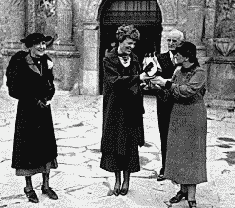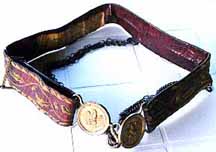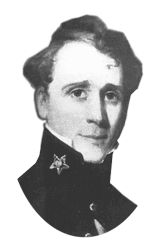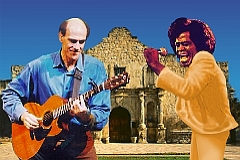|
The Second Flying
Company of Alamo de Parras |
||

Famous
Alamo Visitor Edith Carroll Schneider (right), president of the Zonta Club, presents the six flags of Texas history to flyer Amelia Earhart. Earhart was in San Antonio to give a lecture sponsored by the Zonta Club. Taken February 27, 1936. The San Antonio Light
Collection |
Speaking of
Famous Alamo Visitors
James Taylor & James Brown?? James Taylor of Tennessee and James Brown of Pennsylvania were among the Alamo's defenders in 1836. |
|
 |
Santa Anna's Artificial Leg This artificial leg, made of cork and covered in leather, was crafted by Charles Bartlett, a former cabinet maker from New York City, and sold to General Antonio Lopez de Santa Anna for $1,300. Santa Anna, the Mexican General notorious for his assault on the Alamo in 1836, lost his artificial leg, one of two purchased from Bartlett, at the Battle of Cerro Gordo on April 18, 1847. Santa Anna, while eating a roast chicken lunch some distance from the engagement, was apparently surprised by men of the Fourth Regiment, Illinois Volunteer Infantry. Santa Anna expediently mounted his horse and rode to safety. However, in his haste, the General left behind his roast chicken lunch, $18,000 in specie (money), and his artificial leg. Courtesy Illinois State Military Museum |
|
|
Double your Pleasure. Double your Fun...with Santa Anna? When Antonio Lopez de Santa Anna, the Mexican leader of the Alamo attack, was in exile on Staten Island, N.Y, in 1869, he brought with him a large lump of chicle, the elastic sap of the sapodilla tree, which Mayan Indians had been chewing for centuries. He hoped that Thomas Adams, an inventor, could refine the chicle for a rubber substitute. Adams experimented with the stuff, but it remained lifeless. By chance, he saw a little girl buying paraffin a "pretty poor gum" at a drug store. Adams asked the druggist if he would be willing to try a new kind of gum. He said yes. Adams rushed home, soaked and kneaded the chicle into small grayish balls. The druggist sold all of them the next day. With $55, Adams went into business making Adams New York Gum #1 and set the world to chewing and snapping! Rags to Riches "How Companies or Products Got Their Start" |
||
|
Santa Anna's Belt Brings $14,300 at Auction
Five-time president of Mexico, Antonio López de Santa Anna (1794-1876) is better known for commanding the troops who defeated the vastly-outnumbered American forces at the battle of the Alamo in 1836. |
 |
|
|
The sword belt was acquired by Dr. Anderson Tewksbury during the Civil war and later given to his son, 1900 Summer Olympic gold medalist Dr. Walter Tewksbury. Upon his death, the belt was passed along to his son, Dr. Rowland Tewksbury, from Tunkhannock, Pennsylvania. For over 130 years, the belt had remained in the Tewksbury family. Research by Tony Macek of the auction firm revealed that after the April 18, 1847 battle of Cerro Gordo, Santa Anna's wagon and carriage were captured by American troops, resulting in many of his personal possessions being taken, including his clothing, sword, and belt--even his wooden leg. Starting at $1000 and moving in $500 increments, the belt quickly reached $6000, where the eventual winner, a knowledgeable collector from New York, jumped the bid to $10,000. The bids kept rising until the belt was sold for $14,300 (includes buyer's premium). Source: Maine Antique Digest |
||
 |
Was Emily
Dickinson According to our sources,
the words of most of Emily Dickinson's poetry can be sung to the tune
of "The Yellow Rose of Texas." A Well
What mystery pervades a well!
The grass does not appear
afraid Related somehow they may
be,-- But nature is a stranger
yet To pity those that know her
not
|
|
|
Col. Sidney Sherman from the Ohio / Kentucky border was responsible for bringing the flag used by the Texians, the twin sisters [cannon] and approximately 50 uniformed men (himself splendidly uniformed).to San Jacinto. At San Jacinto, Sherman initiated a mounted relief effort to the Alamo only to find outit had fallen when he reached Gonzales. It was he who began the battle cry, "Remember the Alamo!", "Remember Goliad!" at San Jacinto? Sherman led the ill fated cavalry squirmish to seize the Golden Standard ( Mexican artillery piece ) during which Pvt. Lamar distinguished himself with courage and won Sam Houston's favor. Sam Houston promoted Lamar to Cavalry Commander reassigned and promoted Sidney Sherman to General and granted him the honor to begin the sneak infantry attack from the left Texian flank upon Santa Anna's position at San Jacinto. Sam Houston and Sidney Sherman never liked each other due to Sherman's personal friendship with Burnett, however Sidney Sherman was always a good soldier and obeyed his orders. Source: General Sidney Sherman --Texas Soldier,Statesman and Builder by W. N. Bates. What's in a Name? "The proper name for the people of Texas seems to be a matter of doubt or contrariety: some calling the Texians, while others speak or write Texans, Texonians, Texasians, Texicans. We believe that, both by the Mexican and American residents of the country, the name commonly used is Texians; the Mexicans giving it the guttural sound of the Spanish language, as indicated sometimes by x and sometimes by j, Teghians. The sound is not used in the present mode of speaking the English language, although the Irish use it in the word lough, and the Scotch in loch, a lake. The nearest approximation is in such words as Christ. Texians is, therefore, the
correct name of the people of Texas; and besides being short,
it is perfectly analogous to the usual mode of forming the proper
name of nations by the termination in n; as Greece, Grecian; Persia,
Persian. It may also be considered the euphonious abbreviation of
Texasian. But Texonian and Texasite are absurd epithets.--New Orleans
Bee." Reprinted
in |
||


